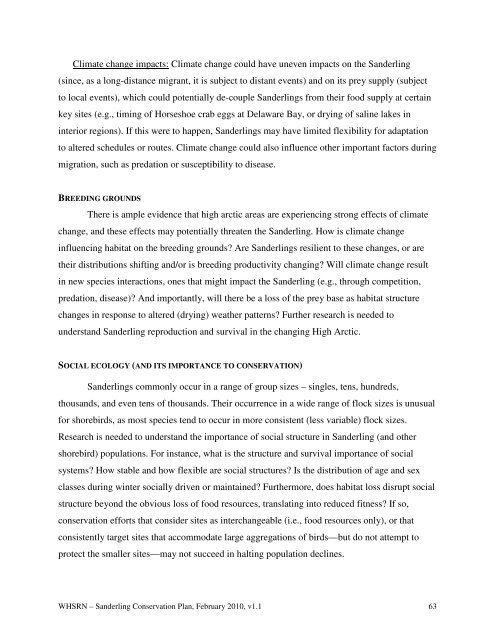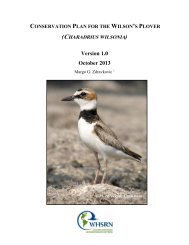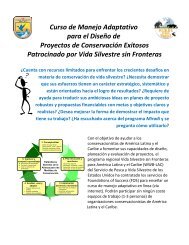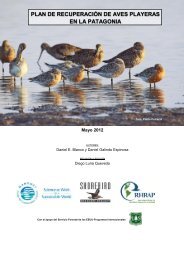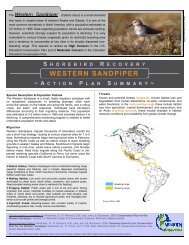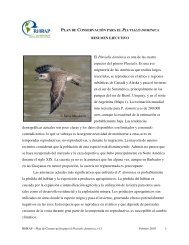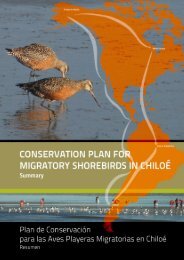Sanderling Plan - Western Hemisphere Shorebird Reserve Network
Sanderling Plan - Western Hemisphere Shorebird Reserve Network
Sanderling Plan - Western Hemisphere Shorebird Reserve Network
You also want an ePaper? Increase the reach of your titles
YUMPU automatically turns print PDFs into web optimized ePapers that Google loves.
Climate change impacts: Climate change could have uneven impacts on the <strong>Sanderling</strong><br />
(since, as a long-distance migrant, it is subject to distant events) and on its prey supply (subject<br />
to local events), which could potentially de-couple <strong>Sanderling</strong>s from their food supply at certain<br />
key sites (e.g., timing of Horseshoe crab eggs at Delaware Bay, or drying of saline lakes in<br />
interior regions). If this were to happen, <strong>Sanderling</strong>s may have limited flexibility for adaptation<br />
to altered schedules or routes. Climate change could also influence other important factors during<br />
migration, such as predation or susceptibility to disease.<br />
BREEDING GROUNDS<br />
There is ample evidence that high arctic areas are experiencing strong effects of climate<br />
change, and these effects may potentially threaten the <strong>Sanderling</strong>. How is climate change<br />
influencing habitat on the breeding grounds? Are <strong>Sanderling</strong>s resilient to these changes, or are<br />
their distributions shifting and/or is breeding productivity changing? Will climate change result<br />
in new species interactions, ones that might impact the <strong>Sanderling</strong> (e.g., through competition,<br />
predation, disease)? And importantly, will there be a loss of the prey base as habitat structure<br />
changes in response to altered (drying) weather patterns? Further research is needed to<br />
understand <strong>Sanderling</strong> reproduction and survival in the changing High Arctic.<br />
SOCIAL ECOLOGY (AND ITS IMPORTANCE TO CONSERVATION)<br />
<strong>Sanderling</strong>s commonly occur in a range of group sizes – singles, tens, hundreds,<br />
thousands, and even tens of thousands. Their occurrence in a wide range of flock sizes is unusual<br />
for shorebirds, as most species tend to occur in more consistent (less variable) flock sizes.<br />
Research is needed to understand the importance of social structure in <strong>Sanderling</strong> (and other<br />
shorebird) populations. For instance, what is the structure and survival importance of social<br />
systems? How stable and how flexible are social structures? Is the distribution of age and sex<br />
classes during winter socially driven or maintained? Furthermore, does habitat loss disrupt social<br />
structure beyond the obvious loss of food resources, translating into reduced fitness? If so,<br />
conservation efforts that consider sites as interchangeable (i.e., food resources only), or that<br />
consistently target sites that accommodate large aggregations of birds—but do not attempt to<br />
protect the smaller sites—may not succeed in halting population declines.<br />
WHSRN – <strong>Sanderling</strong> Conservation <strong>Plan</strong>, February 2010, v1.1 63


